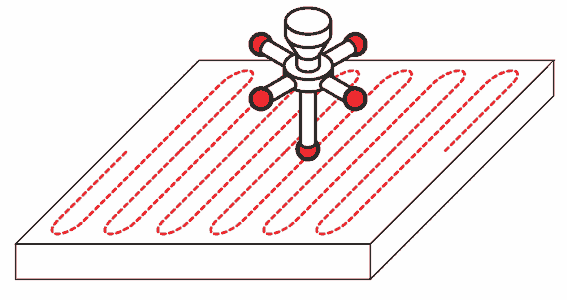Why Choose 3D Scanning for Inspection?
Importance of Inspection

Quality control (QC) careers are on the rise in today’s economy. Advancements in manufacturing technology are pushing the envelope of design capabilities which in turn are driving the need for better ways of inspecting. The need for inspection has, and always will exist. It’s a drive towards perfection, optimization and, overall, a well-oiled machine. That’s why processes exist such as first article inspection (FAI). FAI’s are some of the most common forms of quality control. A FAI ensures an entire production process is able to create products and assemblies that meet the company/consumer requirements. Let’s face it, if a company pumps out bad product do to inadequate, or worse, no QC, then not only will they lose customers; they will be hemorrhaging money.
Things to Consider
Now that we have addressed the need and growth of inspection in today’s market, lets address how we can stop the hemorrhaging caused by bad inspections. Whether you’re manufacturing your 5 millionth widget or your very first, your QC system is only as good as its operators and those operators are only as good as their tools. But in order to find the correct tool for the job, there are a few things you should consider first.

- Complexity of parts – the evolution of designs only pushes towards complexity. We see it in nature, we see it in consumer trends and we now see it in industry. As we strive towards improving on our last design in order to keep up with our competition, we see a growing trend in complexity of parts. The questions you need to be asking yourself are; are my parts simple or complex? Will I be changing the designs to be more complex in the future? Do I have the right tools to inspect them now? Will I have the right tools to inspect them in the future?
- Cost – What is the cost of quality? There is a cost associated with a rejected part, otherwise known as the 1:10:100 rule. Essentially, the rule states that if you catch a problem in production it will cost you 10X more then in development to fix. And if the problem shows up on your doorstep as a rejected part, then it will cost 100X. In this category you need to be asking yourself; What is my cost per part for inspection? What is my cost per part of rejection, in development, production and returned from the customer?
- Market trends – Understanding the market and how it affects your operations is something most don’t consider. Consider this; the tools you currently use for inspection, are they antiquated or cutting edge? Why does this matter you ask? Well if a tool becomes obsolete due to better tools or new models on the market than that may leave your company unsupported when trouble arises. Additionally, your consumers are following the market tends even if you aren’t. If a customer hears that your competition is using the newest technology that boasts more efficiency over older models, they may be more inclined to switch distributors.
- Functionality – As stated before, an operator is only as good as his tools. There exists a multitude of tools for inspection, each with their own strengths and weaknesses and choosing the correct tool could be a daunting task. Without going too far down the rabbit hole, there are a few criteria that are worth focusing on.
- Ease-of-Use – does the tool you currently use require a higher level of education? For example, if you were to hire an operator would you be looking for someone with extensive use on the device or would it be easy to train them internally on the tool?
- Versatility – Can the device you currently use be operated in different environments? What if you need to inspect a part on the line or in the field?
- Human error – There will always exist some form of uncertainty created by the tool, but certain inspection tools can create higher amounts of error due to the operator. For example, tools that require contact with a part such as calipers or CMM’s may cause the greatest error from the user due to slippage when extracting, physical pressure applied, flexibility of the part, incorrect area targeted and overall assumptions.
- Accuracy – For most companies, accuracy tends to be the most important feature of an inspection tool. Opting for a device that offers good accuracy ensures reliable measurements and usable data. The objective is often to achieve a perfect design fit, without the need for iterations. Therefore, having accurate measurements on the first draft saves time and money. Something to consider is the cost of accuracy and repeatability. Most companies shoot for a higher accuracy; usually 1:5 or 1:10 to accommodate for low repeatability and user error. But there is a scalable cost associated with accuracy and something to consider is whether a high accuracy is needed. Searching for a device with a higher repeatability factor maybe a better bang for the buck.
- Speed – Most would agree that the less time spent on a task the better and this statement holds true for inspection as well. Faster turnaround times mean quicker problem identification which in-turn means less money lost throughout the process, especially if caught in development or first run production.
Equipment
 3D scanning technology has been around since the 1960’s and was more of a conceptual prototype at the time. But over the last 60 years the technology quickly evolved into an easy to use, hand-held device for scan-to-print, reverse engineering and inspection. Though there exists a gamut of scanners on the market; everything from the hobbyist level to military grade, for applications of PPAP and first article inspection the search should begin in the metrology variety of scanners. A metrology grade scanner is regulated by a set standard for inspection tools, usually by a NIST college (National Institute of Standards and Technology). This gives you piece of mind that the data extracted by the scanner are accurate and highly repeatable. Which means you now have a tool that will provide reliable measurements, independent of the operator. We can now check off
3D scanning technology has been around since the 1960’s and was more of a conceptual prototype at the time. But over the last 60 years the technology quickly evolved into an easy to use, hand-held device for scan-to-print, reverse engineering and inspection. Though there exists a gamut of scanners on the market; everything from the hobbyist level to military grade, for applications of PPAP and first article inspection the search should begin in the metrology variety of scanners. A metrology grade scanner is regulated by a set standard for inspection tools, usually by a NIST college (National Institute of Standards and Technology). This gives you piece of mind that the data extracted by the scanner are accurate and highly repeatable. Which means you now have a tool that will provide reliable measurements, independent of the operator. We can now check off 
 To put this in perspective, if you have ever used a traditional CMM or a depth gauge to collect data for flatness then you know it takes a decent amount of points and time to correctly measure. Now picture using a scanner instead, with in a second you have confidently and accurately measured the flatness. This checks off our box
To put this in perspective, if you have ever used a traditional CMM or a depth gauge to collect data for flatness then you know it takes a decent amount of points and time to correctly measure. Now picture using a scanner instead, with in a second you have confidently and accurately measured the flatness. This checks off our box 



Identifying where your inspection tool falls into the current industrial market could be an eye-opening experience and you could be hemorrhaging more money then realized. Considering the manufacturing industry will continually grow and the demand for more complexity is ever prevalent. Overall as we strive to improve our capabilities in the QC world, 3D scanning has stepped up the inspection game by providing more reliable measurements, plugin-play functionality and unparalleled speed.
For more information on 3D scanning visit our 3D scanning blog section at CATI.com.
The engineer’s first problem in any design situation is to discover what the problem really is.
Bob Renella
Product Manager
Computer Aided Technology, LLC

 Blog
Blog